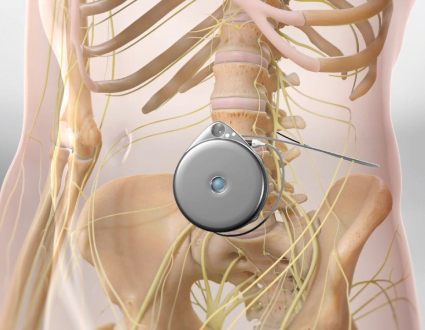Precise Pain Relief, Minimized Side Effects
Intrathecal Pump Implant
- Home
- Treatments
- Intrathecal Pump Implant
A “pain pump” is a method of giving medication directly to your spinal cord. The system uses a small pump that is surgically placed under the skin of your abdomen. The pump delivers medication through a catheter to the area around your spinal cord. Because the drug is delivered directly to the pain area, your symptoms can be controlled with a much smaller dose than is needed with oral medication. Thus reducing the side effects of medication.


FAQs - Intrathecal Pump Implant
The fluid-filled space around your spinal cord is called the subarachnoid or intrathecal space. Cerebrospinal fluid (CSF) flows through this area, bathing and protecting your brain and spinal cord. An intrathecal drug pump works more efficiently than oral medication because it delivers medicine directly into the CSF, bypassing the path that oral medication takes through your body. In fact, you generally need about 1/300 the amount of medication (morphine or baclofen) with a pump than when taken orally.
The pump is a round metal device about the size of a hockey puck that is surgically implanted beneath the skin of your abdomen. A small plastic tube, called a catheter, is surgically placed in the intrathecal space of the spine and is connected to the pump. A space inside the pump called the reservoir holds the medication. The pump is programmed to slowly release medication over a period of time. It can also be programmed to release different amounts of medication at different times of the day, depending on your changing needs. The pump stores the information about your prescription in its memory, and your doctor can easily review this information with the programmer. When the reservoir is empty, the doctor or nurse refills the pump by inserting a needle through your skin and into the fill port on top of the reservoir.
This therapy is completely reversible if you should ever decide to have the pump removed.
The treatment for intrathecal pain pump implants involves a surgical procedure to place the pump into the body. First, anesthesia will be administered to ensure you remain safe and comfortable throughout the procedure. Next, a catheter will be placed in the spine. This will create a space for the intrathecal pump to deliver medication. Then, an incision is made below the waistline, where the pump device will be inserted. Once the pump is in place, the incisions will be closed and your treatment will be complete.
As with any surgery, you will need to avoid heavy lifting and other strenuous activities for several weeks after your procedure. You may want to walk regularly to stimulate the healing process. You can take pain medication to manage any discomfort that follows your surgery.
Once the intrathecal pain pump is in place, patients can begin enjoying pain relief from the regular supply of pain medications to the spine. You can also expect an overall improvement in your quality of life due to increased mobility and an ability to resume your usual activities. After the initial pain pump implant, your medication can be refilled with simple injections into the pump system.


